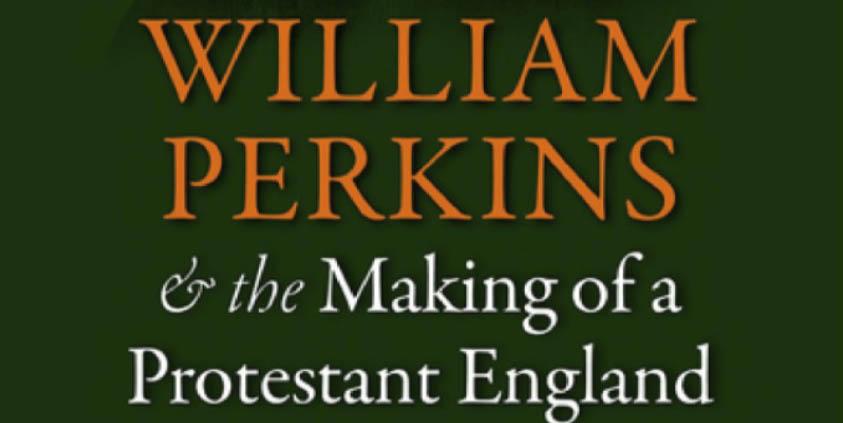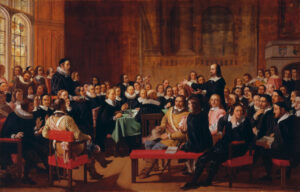William Perkins and the Making of a Protestant England. By W.B. Patterson. Pp.xi+265 Oxford: Oxford University Press, 2014. £65. 978-0199681525
Reviewed in the Journal of Ecclesiastical History 67 (2016), pp.197-8.
W.B. Patterson’s William Perkins and the Making of a Protestant England is a first-rate study that fills a major historiographical gap by providing a long-awaited, well-researched, and extensive treatment of the life and of virtually all the major works of the English clergymen William Perkins. Building on the work of previous historians like R.T. Kendall and Ian Breward, it argues that Perkins was ‘the most important and influential contemporary theologian of the Elizabethan Church of England in advancing its teachings and values and in shaping the Protestant religious culture of the nation’ (p.63). Additionally, it ambitiously attempts to modify our view of Perkins’s churchmanship, by contending that Perkins ‘was not so much an Elizabethan Puritan as he was an apologist, perhaps the chief apologist, for the Church of England’ (p.40).
Chapter one sets up the rest of the work by providing a very helpful overview of the broader context of the Elizabethan period. Chapter two—undoubtedly the most controversial portion of the book—attempts to replace Perkins’s longstanding status as a puritan with the view that he was a deeply committed member of the Elizabethan Church. While chapter three analyzes how Perkins’s works on predestination and salvation were staple texts used by English and Continental churches, chapter four persuasively puts forward Perkins as ‘the principal founder of English Protestant casuistry’, who ‘brought casuistry out of the realm of professional clerical adjudication into the world of lay experience’ (p.113). Chapter five rejects Christopher Haigh and Peter Kauffman’s arguments that Perkins’s ‘plain style’ of preaching was received by his parishioners as academically rigid and pastorally shameful. Instead, it convincingly demonstrates that Perkins successfully ‘raise[d] up an educated preaching ministry in the Elizabethan Church’ (p.129). Chapter six illustrates how Perkins was a chiefly concerned to ‘confront the economic and social problems’ of his day (p.217). Chapter seven fruitfully examines Perkins’s anti-Catholicism, through the lens of the afterlife of A Reformed Catholike, and argues that its subsequent translations helped to preserve Perkins’s reputation as an anti-Catholic polemicist. Chapter eight highlights his ongoing influence in England, through both his republished works and the influential ministries of his protégés, including Samuel Ward and William Ames. Indeed, Perkins had (by Ian Green’s definition) more Protestant best sellers than ‘any other English religious writer during the long English Reformation’ (p.191).
Patterson displays an admirably sympathetic approach to his subject, while at the same time providing a thorough investigation of Perkins’s printed works and consistently linking Perkins’s life and thought to the broader political and ecclesiastical themes of the Elizabethan period. These strengths make this deeply informative study enjoyable to read. Although Patterson rightly points out that Perkins has clear ties with established Church members—especially the Calvinist bishops William Bedell and James Montague (p.61)—some readers might find it difficult to accept Patterson’s conclusion that ‘there is little to link Perkins’ to the puritan Elizabethan puritan movement (p.49). It would be possible to draw different conclusions than Patterson regarding Perkins’s testimony before the Privy Council (concerning his presence at the 1589 classis meeting). Could it be that Patterson downplays the fact that this event was indeed a proto-Presbyterian meeting organized to discuss plans for revising the polity of the Church of England? Perhaps Patterson’s suggestion that Perkins attended the meeting because he was ‘asked’ ‘to give his opinion on’ the Book of Discipline (p.46) overlooks the possibility that Perkins genuinely may have wanted to alter the established Church’s polity? Indeed, Patterson’s central argument–that Perkins ‘considered the established Church sound in its liturgy, polity, and doctrinal standards’ (p.62)—may slightly devalue other evidence of Perkins’s reforming tendencies and give the impression that Perkins was entirely content with the established Churches’ doctrine and discipline. He appears somewhat reticent about engaging with the arguments of Patrick Collinson and Peter Lake about moderate puritanism, despite the fact that his contentions strike at the heart of the debate about whether we can actually identify puritans. Nevertheless, these points should not in any way detract from the fact that Patterson’s work is a model for biographical study and a an admirably rich and definitive account of Perkins’s life and works. Undoubtedly, it will provoke further thinking about how we understand and define puritanism and Protestantism in early modern England.




